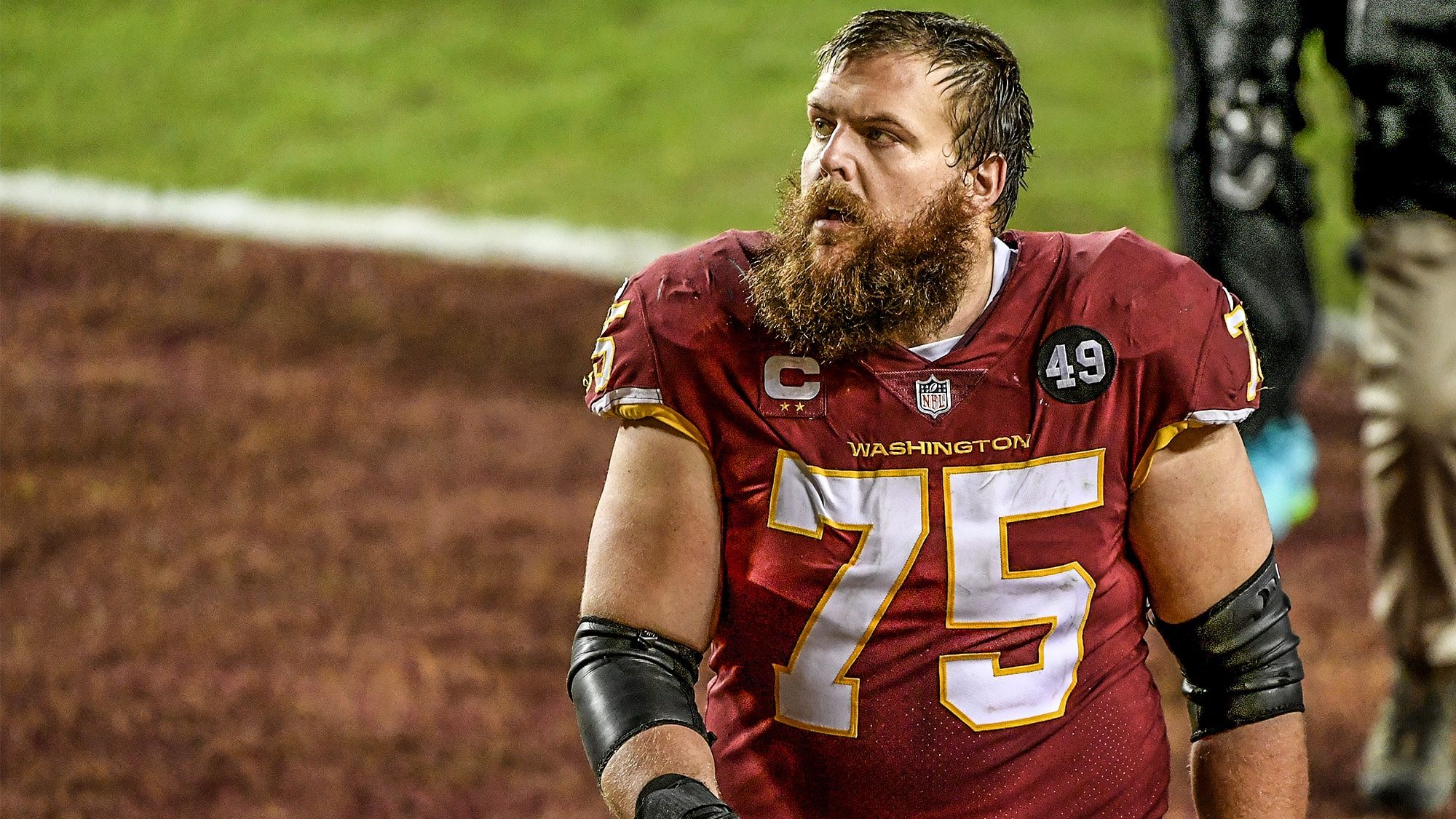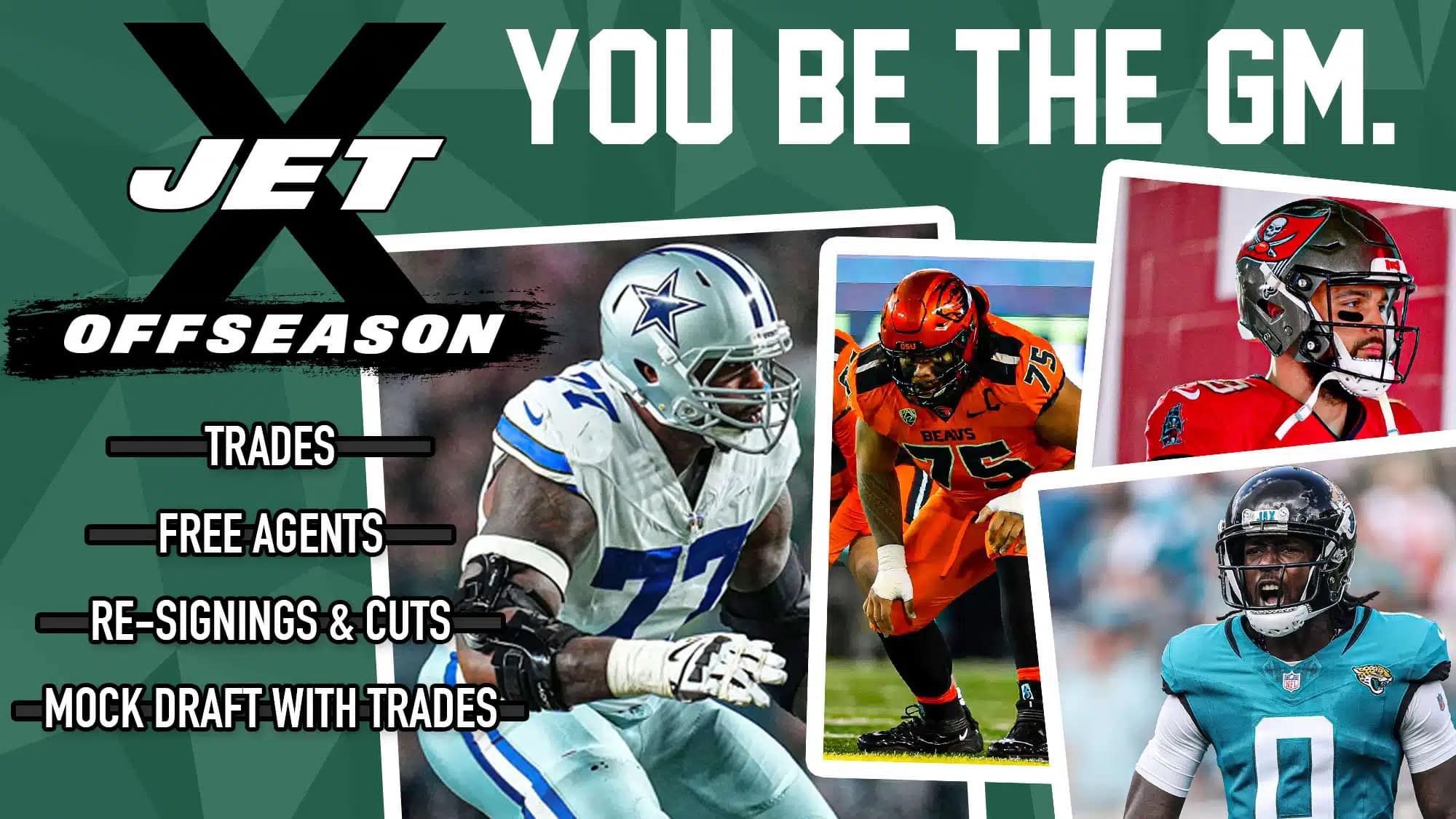Here are the top free agents that have the ability to solve the New York Jets’ biggest problems from the 2020 season.
Weakness: Pass protection at guard
The New York Jets‘ guards were a massive problem in the passing game throughout the 2020 season. Greg Van Roten had a stretch of decency during the middle portion of the season, but otherwise, the position was a mess. Van Roten started the season brutally, and every other guard to appear for the Jets – Alex Lewis, Josh Andrews, and Pat Elflein – was terrible in pass protection all year.
With a combined total of 97 pressures allowed over 1,282 protection snaps, the Jets’ guards allowed a pressure rate of 7.6%, worst in the NFL. The 2020 league average for guards was 4.5%.
- Greg Van Roten: 5.0%
- Alex Lewis: 6.9%
- Pat Elflein: 10.0%
- Josh Andrews: 13.3%
Solutions: Brandon Scherff, Joe Thuney
Well, this is an obvious one for anybody who has following free agency closely over the past few months. Scherff and Thuney are superstar guards, ready to provide an immediate upgrade for whichever team is willing to dump a boatload of dough on them.
Over the past three seasons, Scherff allowed a pressure rate of 3.24%, ranking third-best among right guards behind Zack Martin (3.19%) and Kevin Zeitler (3.08%). Across the same span, Thuney was even cleaner with a rate of 3.06% that ranked fourth-best among left guards, trailing only Quenton Nelson (2.98%), Elgton Jenkins (2.94%), and Joel Bitonio (2.44%).
It is incredible to think about how gargantuan of an upgrade Scherff and Thuney could be. Let’s start with Thuney at left guard. In 2020, Alex Lewis allowed multiple pressures in six of his nine games. Thuney, on the other hand, has given up multiple pressures in six of his last 36 regular season and playoff games, spanning throughout the past three seasons.
At right guard, Scherff has allowed multiple pressures in 11 of his past 34 games dating back to 2017. In 2020, the Jets’ starting right guards (Van Roten for 13 games, Andrews for 3) allowed multiple pressures in 10 of 16 games.
Signing the elite Corey Linsley (PFF’s No. 1 center in 2020) to play center and kicking Connor McGovern over to guard is an option, as McGovern played guard in college and throughout his first three professional seasons, but we have yet to see McGovern prove he can protect effectively at that position in the NFL. McGovern gave up a pressure rate of 7.0% over 13 extended appearances at right guard from 2017-18.
Considering the severe lack of depth in the free agent guard pool – there are no other qualified unrestricted free agent guards who were above-average in both pressure rate allowed and PFF’s pass blocking grade last year except for Kelechi Osemele – the Jets will have to be extremely aggressive in their pursuit of Scherff and/or Thuney if they want to improve one of the weakest positions on their roster. If they miss out on both, they are simply not going to find a clear upgrade at guard prior to the draft (barring a trade).
Joe Douglas is known as a frugal spender, but the wisest move for his team in this particular situation might just be to do whatever it takes to outbid the opposition for one of these two star guards. Sometimes, being an aggressive spender on the open market is smart. This may be one of those times.
Weakness: Explosiveness at running back
As you would expect when 99-year-old Frank Gore is getting the majority of the carries, the Jets had one of the league’s least explosive running back rooms in 2020.
The Jets’ running backs averaged 0.33 open field yards per carry, meaning that, on their average carry, they gained only 0.33 yards beyond 10 yards downfield. That mark ranked second-worst in football, ahead of only the Christian McCaffrey-less Panthers (0.32).
In total, New York’s backfield picked up just two rushes that eclipsed 20 yards; a 25-yarder by Josh Adams against the Raiders in Week 13 and a 34-yarder by Ty Johnson against the Dolphins in Week 12.
Fortunately, there are some good solutions on the open market that would provide excellent home-run-hitting potential while coming at a cheap cost. One of the names – and perhaps the best option – is a very familiar one for Jets fans.
Play: 👉 the Jet X Offseason Simulator
Solutions: Josh Adams, Wayne Gallman, Samaje Perine
Bringing back Josh Adams – who is a restricted free agent – would be one of the Jets’ best bets to improve their home-run potential at running back. It was a small sample, as he carried the ball only 29 times, but he was by far the Jets’ most explosive back last season.
Here is how each running back on the roster fared when it came to open field yards per carry (the 2020 RB average was 0.68):
- Josh Adams: 0.93
- Ty Johnson: 0.67
- La’Mical Perine: 0.23
- Frank Gore: 0.13
Here is how the crew compared when it came to picking up rushes for 10+ yards (the 2020 RB average was 11.3%):
- Josh Adams: 5 rushes for 10+ yards on 29 carries (17.2%)
- La’Mical Perine: 5 on 64 (7.8%)
- Ty Johnson: 4 on 54 (7.4%)
- Frank Gore: 13 on 187 (7.0%)
Lightening the risk of that small sample size is the fact that Adams was a solid big-play threat over his 120-carry season for the Eagles in 2018 as well. That year, he averaged 0.88 open field yards per carry and picked up 10+ yards on 14 of his 120 carries (11.7%). Perhaps Adams is for real and has simply been overlooked by the league.
Samaje Perine, cousin of La’Mical, is coming off of a similar season to Adams, flashing a lot of juice with a small sample of touches. Perine picked up 301 yards and three touchdowns on just 63 carries for the Bengals (4.78 yards per carry). He ran for 10+ yards on an impressive 14.2% of his carries (9 of 63) and averaged a sparkling 1.05 open field yards per carry.
Unlike Adams, however, Perine was not impressive prior to 2020. Perine’s last season with a substantial amount of carries was his 2017 rookie year with Washington, and he struggled mightily, posting marks of 3.45 yards per carry and 0.25 open field yards per carry while gaining 10+ yards on only 7.4% of his attempts. So, Perine has a legitimate sample-size red flag attached to him, but his 2020 season is definitely one that catches the eye, making him a worthy gamble on a deal with little-to-no guarantees.
Wayne Gallman is another interesting option. Gallman was an unexciting rusher for the Giants over the first three years of his career (3.99 yards per carry), but in 2020, he had a breakout season. He carried the ball 147 times for 682 yards and six touchdowns, averaging an efficient 4.64 yards per carry. Gallman averaged 3.63 yards after contact per carry, a mark that ranked fourth-best among running backs with at least 100 carries.
However, Gallman is not much of a home-run hitter, picking up 10+ yards on a slightly-below-average 10.1% of his carries, so he does not check the “explosiveness” box we’re looking for here. He’s more of a consistent chunk-gainer type of back.
Nonetheless, Gallman was still a highly efficient rusher overall, and the Jets need efficiency at the running back position however they can get it after a season in which the running back position limited their run game’s productivity. The Jets ranked 26th in rushing DVOA despite ranking 19th in Pro Football Focus’ team run blocking grade (65.2) and 16th in Football Outsiders’ adjusted line yards (4.35). That disparity suggests the running back position deserves the bulk of the blame for the lack of rushing production. Most of that blame should be placed upon the group’s top dog, Gore, while Perine deserves a smidgen of blame as well.
Adams (5.41 yards per carry) and Ty Johnson (4.70) capitalized on the offensive line’s decent blocking and then some, combining for 4.95 yards per carry, a mark that demolishes the 3.53 average produced by the combination of Gore (3.49) and Perine (3.63).
Running it back with Adams and Johnson could be the most sensible path for the Jets. It would be extremely cost-effective while still boasting top-tier upside based on the small sample we saw from the duo last season.


